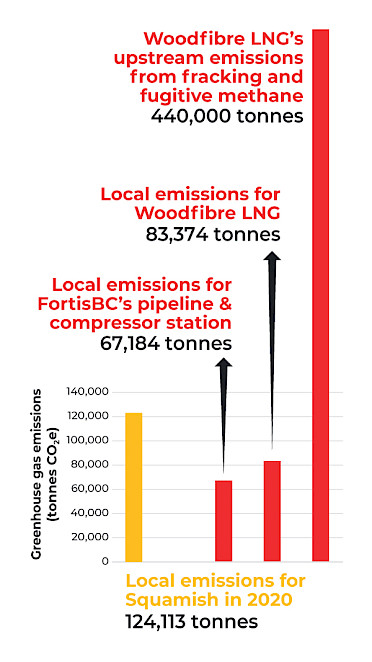Adding fuel to the fire
LNG is a fossil fuel that consists almost entirely of methane, which is 84–87 times more potent at warming the atmosphere than carbon dioxide.
Woodfibre LNG claims that exporting LNG will reduce emissions in Asia by displacing coal-powered electricity, but a recent analysis shows that the life-cycle emissions from BC's LNG are worse than coal.
Studies also show there is no way to guarantee that LNG will replace coal as an energy source in the importing jurisdiction, and the industry acknowledges that LNG is in direct competition with renewable energy.
To make things worse, methane emissions from fossil fuel extraction are 25–40% higher than previously estimated and B.C. is underreporting fugitive methane emissions.
Both the Intergovernmental Panel on Climate Change and the International Energy Agency have called on world governments to immediately stop investments in and approvals of new oil and gas projects to limit global temperature rise to 1.5°C.
We need to cancel the permits for new fossil fuel infrastructure like Woodfibre LNG that will lock in climate pollution for decades, and quickly transition to safe and reliable renewable energy.

Net zero is not zero
Woodfibre LNG’s “Roadmap to net zero” only focuses on local emissions, ignoring upstream emissions from fracking, production, and processing the gas; and downstream emissions from shipping, regasification, and final consumption; not to mention the fugitive methane leaking into the atmosphere at every step.
To electrify its LNG facility and fracking operations, Woodfibre LNG would need 40% of the electricity from Site C dam. This risks diverting B.C's limited energy supply to greenwash LNG production, which will reduce the electricity available to decarbonize buildings and transportation.
Woodfibre LNG’s roadmap also relies on unproven technologies like carbon capture, utilization, and storage (CCUS); and carbon credits, which have been exposed as greenwashing.
This makes Woodfibre LNG’s net zero plans “largely meaningless.”
References
Natural Resources Canada 2023. Liquefied Natural Gas in Canada. Website accessed 2024-03-04.
IEA 2021. Methane Tracker 2021, International Energy Agency, Paris.
Hughes JD 2020. BC’s Carbon Conundrum. Canadian Centre for Policy Alternatives. Report, 60 pp.
Greenford DH 2023. Burning Bridge: Debunking LNG as a Climate Solution. David Suzuki Foundation. Report, 50 pp.
IEA 2019. The Role of Gas in Today's Energy Transitions. International Energy Agency, Paris. Report 110 pp.
Hmiel B et al 2020. Preindustrial 14CH4 indicates greater anthropogenic fossil CH4 emissions. Nature, 578, pages 409–412 (2020).
Atherton E et al 2017. Mobile measurement of methane emissions from natural gas developments in northeastern British Columbia, Canada. Atmos. Chem. Phys., 17, 12405–12420.
IPCC 2022. Climate Change 2022: Mitigation of Climate Change. Contribution of Working Group III to the Sixth Assessment Report of the Intergovernmental Panel on Climate Change. Cambridge University Press, Cambridge, UK and New York, NY, USA.
IEA 2021. Net Zero by 2050, International Energy Agency, Paris. Report, 224 pp.
Woodfibre LNG 2023. Woodfibre LNG's Roadmap to Net Zero. Report, 33 pp.
Gorski J and Lam J 2023. Squaring the circle: reconciling LNG expansion with B.C.'s climate goals. Pembina Institute. Report, 32 pp.
Allen T 2022. A magical CCUS unicorn will not save the oil industry. Carbon Tracker Initiative, published 2022-07-22.
Greenfield P 2023. Revealed: more than 90% of rainforest carbon offsets by biggest certifier are worthless, analysis shows. The Guardian, published 2023-01-18.